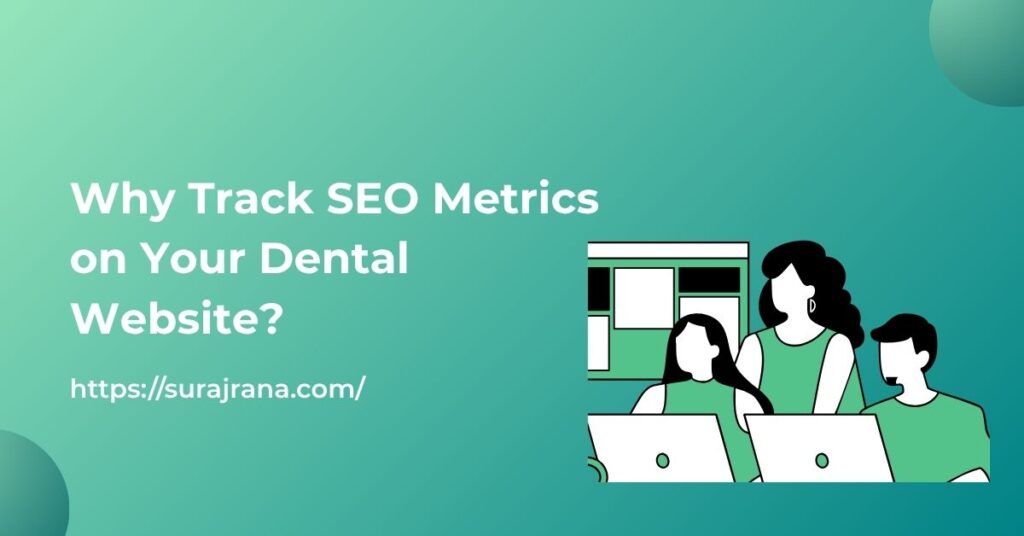Running a dental practice without checking your website’s performance is like trying to treat patients without ever looking at an X-ray.
You might be doing everything right—but how would you know? That’s where SEO metrics come in.
These numbers are more than just stats on a screen. They show you how well your website is helping potential patients find your clinic online.
Without tracking these metrics, you could be missing out on chances to grow your practice and connect with people actively searching for dental care in your area.
Let’s break this down into simple terms so you can understand why these numbers are essential and how to use them to your advantage.
What Are SEO Metrics and Why Should Dentists Care?
Simple Explanation of SEO Metrics
SEO metrics are like a report card for your dental website. They show how many people are visiting your site, how they found it, what pages they looked at, and whether they took action—like calling you or booking an appointment.
Think of it like checking how many people walk past your clinic, who steps inside, and how many actually sit in the chair for treatment.
On the web, these interactions are tracked through tools like Google Analytics and Search Console. You don’t need to be tech-savvy to understand them.
Partnering with a Dental Marketing SEO Agency can help you make sense of these numbers and use them effectively.
Once you know what each metric means, it becomes much easier to improve your website and attract more patients.
Why They Matter for Your Practice
Most people these days search online when they need a dentist. If your website isn’t showing up or doesn’t keep their attention, they’ll simply move on to someone else.
SEO metrics help you figure out if your website is visible in search results and whether visitors are finding what they need once they land on it.
When you understand what people are doing on your site, you can make changes that help more of them stay longer, read your services, and eventually book appointments.
That’s how your website turns into a tool that supports your clinic’s growth—not just an online brochure.
Key SEO Metrics Every Dental Website Should Track
Website Traffic – Who’s Visiting and Why
Website traffic tells you how many people are coming to your site over a certain time period. It also shows where they’re coming from—whether they found you through Google, a social media post, or a referral from another website.
If you notice that your traffic is going up after posting a new blog or updating your service pages, that’s a sign those efforts are working.
If it’s staying flat or dropping, you might need to refresh your content or improve your local SEO.
Understanding your traffic sources helps you see which marketing channels are actually helping bring in new potential patients.
Bounce Rate – Are Visitors Sticking Around?
Bounce rate shows the percentage of people who leave your site after viewing just one page.
A high bounce rate often means that visitors aren’t finding what they expected or the site didn’t load fast enough.
If your homepage has a high bounce rate, you might need to make it clearer, faster, or more welcoming.
Sometimes, even small tweaks—like simplifying the language or adding clear contact buttons—can make a big difference in keeping people engaged.
Conversion Rate – From Clicks to Appointments
Your website might get hundreds of visitors a week, but if no one books an appointment, something is wrong.
The conversion rate tells you how many people take an action—like calling, filling out a contact form, or booking online—compared to how many visited.
Tracking this helps you measure the real success of your website. You’ll know which pages turn visitors into patients and which ones need better wording, stronger calls-to-action, or easier navigation.
Keyword Rankings – How You Appear on Google
When someone types “family dentist in West Ryde” into Google, your keyword ranking determines whether your website shows up on the first page—or not at all.
By tracking keyword performance, you can see which search terms are helping you get found and which ones need improvement.
If your main services like teeth whitening or braces aren’t ranking well, it might be time to update your content or add more helpful information around those topics.
Google Business Profile Views and Actions
Your Google Business Profile is one of the most powerful tools for local dental SEO.
Tracking how often people view your profile, click “Call,” or get directions gives you insight into how visible and effective your clinic is in your local area.
If your profile is getting lots of views but few calls, you might need to improve your photos, reviews, or clinic description. These small updates can have a big impact on your local visibility.
How Tracking SEO Metrics Helps Your Dental Clinic Grow
Learn What’s Working (And What’s Not)
One of the biggest benefits of SEO metrics is learning what’s actually helping your clinic grow. Maybe a blog post about “How to Help Kids Overcome Dental Fear” is bringing in a lot of traffic. Or maybe your implant service page is underperforming despite being a key offering.
By looking at these numbers, you can decide which pages or services to promote more, which ones to improve, and which might need a complete rewrite.
It’s a smarter way to manage your website—based on real user behaviour instead of guesswork.

Make Smart Choices with Real Data
Let’s say you redesigned your homepage or added online booking. SEO metrics can tell you whether those changes helped or hurt.
Are people staying longer? Are more appointments being booked? If not, you know it’s time to revisit your changes.
Data like this helps you avoid wasting time and money on things that don’t work. It’s about making small, smart decisions that add up to big wins over time.
Stay Ahead of Local Competitors
Many dental clinics are still behind when it comes to using SEO data. If you take the time to track and understand your metrics, you’ll be in a much better position to rank higher in local searches and appear more often in front of potential patients.
Working with a Professional Dental SEO Service can give you the support needed to monitor performance, adjust your strategy, and stay visible in a competitive market.
Keeping an eye on your rankings and web traffic also helps you react faster to changes in search trends—something your competitors might not be doing.
Tools That Help You Track SEO Metrics Easily
Google Analytics
Google Analytics is a free tool that gives you loads of helpful information. You can see how many people are visiting, which pages they like most, how long they stay, and what devices they’re using. It’s like having a behind-the-scenes look at how your website performs.
Even if you only check a few simple stats each week—like total visitors and conversion rate—you’ll learn a lot.
Google Search Console
Search Console is another free tool from Google, but it focuses more on how your website appears in search results. It shows which keywords people typed in before landing on your site, which pages get the most clicks, and if there are any problems that need fixing.
This tool is especially useful for making sure your site is being indexed correctly and that there are no technical issues holding you back.
Other Helpful Tools for Dental Clinics
While Google’s tools are a great starting point, there are others that can give even deeper insights. Tools like SEMrush or Ahrefs can show you keyword trends and backlinks. BrightLocal is great for tracking how you show up in local searches.
If you use call tracking tools like CallRail, you can even see which pages or ads are leading to real patient calls. Together, these tools give you a full picture of how your online presence is helping your clinic grow.
Common Mistakes Dentists Make with SEO Metrics
Ignoring Data Because It Seems Too Technical
A lot of dentists avoid SEO metrics because they think it’s too complicated. But you don’t need to understand every chart or graph. Start with the basics—traffic, bounce rate, and conversions—and go from there.
If you’re working with an expert like Suraj Rana, they’ll explain things in simple terms and focus on the numbers that actually impact your business.
Looking at the Wrong Numbers
Not all metrics are equally helpful. Some stats, like page views or time on site, can be interesting but don’t always reflect success.
Focus on numbers that tie directly to new patient growth—like conversion rate, keyword rankings, and calls from your Google listing.
This way, you won’t be distracted by numbers that look good but don’t help you grow.
Giving Up Too Soon
SEO takes time. You might track your numbers for a month and feel like nothing’s changing. But small improvements add up.
Moving from page two to page one on Google can make a big difference in patient calls.
Stick with it, and you’ll start seeing results. SEO isn’t about instant wins—it’s about building steady, long-term success.
Conclusion
Tracking SEO metrics is one of the smartest moves you can make for your dental clinic. These insights reveal how well your website performs, what content visitors are drawn to, and whether they’re actually becoming patients.
You don’t need to be a tech expert to get started. Free tools like Google Analytics and Search Console are simple to use once you know what to focus on.
With consistent tracking, you can improve your site, increase traffic, and support long-term clinic growth.
If you’re unsure where to begin, partnering with someone experienced—like Suraj Rana—can make the process easier and more effective.
Start paying attention to your numbers today. It’s the first step to turning your website into a patient-generating asset.

My name is Suraj Rana, and I am a seasoned Dental SEO Specialist with extensive experience in the Dental SEO industry. Leveraging my deep knowledge and expertise, I help dental practices enhance their online visibility and attract more patients.


